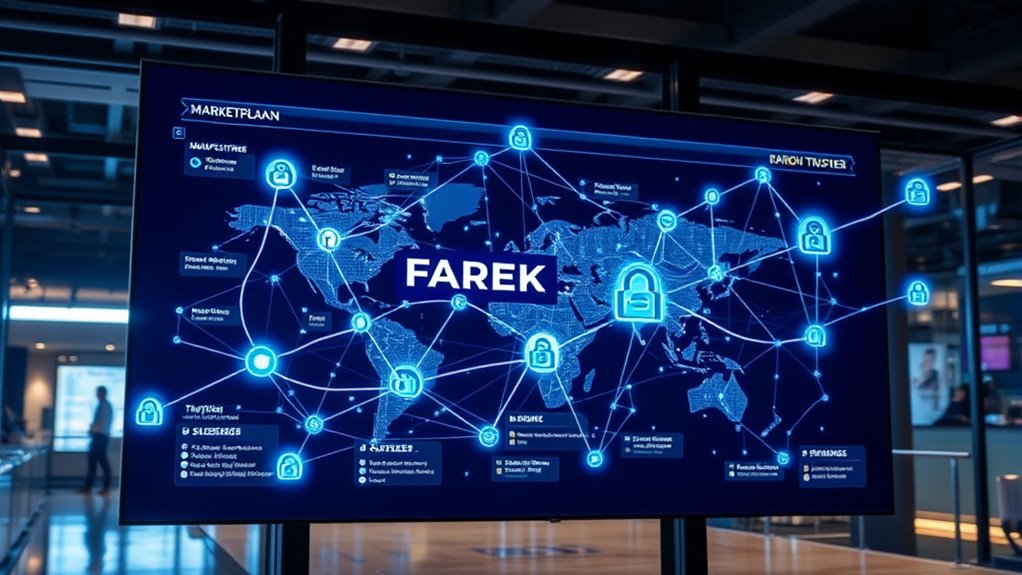Blockchain technology secures supply chains in virtual fabric marketplaces by providing transparent, tamper-proof records of transactions, ownership, and origins through digital assets. Smart contracts automate agreements, ensuring transactions happen only when predefined conditions are met, reducing errors and disputes. This creates a trusted environment where stakeholders can verify authenticity, track movement, and streamline processes securely. As you explore further, you’ll discover how these innovations foster greater transparency and efficiency across the entire fabric industry.
Key Takeaways
- Blockchain creates tamper-proof digital assets representing fabrics, ensuring authentic ownership and provenance verification.
- Smart contracts automate transactions when predefined conditions are met, reducing delays and human errors.
- Every movement and transaction in the supply chain is securely logged, providing an auditable and transparent trail.
- Digital assets and blockchain security prevent fraud, counterfeiting, and unauthorized data tampering.
- Real-time data sharing and visibility improve supply chain efficiency, compliance, and stakeholder trust.

Have you ever wondered how digital platforms are transforming the fabric industry? It’s a revolution driven by blockchain technology, which introduces new ways to manage and secure supply chains through virtual fabric marketplaces. At the heart of this transformation are digital assets—digital representations of physical fabrics or related data—that streamline transactions and tracking. These digital assets serve as a transparent, tamper-proof record of ownership, origin, and movement, reducing the risk of fraud and counterfeiting. When you leverage these assets within a blockchain ecosystem, it becomes much easier to verify authenticity and provenance, giving buyers confidence in what they’re purchasing.
Smart contracts play a vital role in this new landscape. Think of them as self-executing agreements coded directly into the blockchain. When certain conditions are met—say, delivery confirmation or quality verification—the smart contract automatically triggers payment or updates the ownership record. This automation not only speeds up transactions but also minimizes disputes, as every step is recorded on an immutable ledger. In a virtual fabric marketplace, smart contracts enable seamless, secure transactions between manufacturers, suppliers, and retailers, eliminating the need for intermediaries and reducing delays. This results in a more efficient, transparent supply chain that everyone can trust.
By integrating digital assets and smart contracts, blockchain secures the entire fabric supply chain from raw material to finished product. Every movement and transaction is logged securely, providing an auditable trail accessible to all authorized parties. This transparency helps identify bottlenecks and inefficiencies while ensuring compliance with industry standards. As a result, you get real-time visibility into inventory levels, quality control, and shipment statuses. With blockchain, disputes over delivery or quality issues are resolved faster because the platform provides definitive proof of each transaction, minimizing costly delays and disputes. Additionally, understanding the importance of color accuracy ensures that textiles and fabrics are represented with true-to-life colors, which is crucial in maintaining quality standards.
Moreover, virtual fabric marketplaces powered by blockchain foster collaboration across the supply chain. Participants can share data securely, access verified digital assets, and execute smart contracts with confidence. This interconnected system reduces information asymmetry and enhances trust among stakeholders. As you engage with these platforms, you’ll notice how blockchain’s security features protect sensitive data from tampering or unauthorized access, further reinforcing confidence in the entire supply chain. Overall, by harnessing digital assets and smart contracts, blockchain creates a resilient, transparent fabric industry that adapts to modern demands for accountability, efficiency, and trust.
Frequently Asked Questions
How Does Blockchain Improve Transparency in Virtual Fabric Marketplaces?
Blockchain improves transparency by providing a secure, immutable record of transactions. When you integrate blockchain into virtual fabric marketplaces, it enhances fabric provenance by tracking each step of the supply chain. This way, you can verify the origin and authenticity of fabrics easily, reducing fraud and ensuring trust. Blockchain’s transparency allows all stakeholders to access real-time data, making the entire process more accountable and reliable.
What Are the Main Challenges of Implementing Blockchain in Supply Chains?
Implementing blockchain in supply chains faces significant challenges like regulatory hurdles and integration complexities. You might encounter legal uncertainties across different regions, slowing adoption. Additionally, integrating blockchain with existing systems can be technically demanding, requiring substantial resources and expertise. These hurdles can delay deployment and increase costs, but addressing them is vital for leveraging blockchain’s benefits of transparency, security, and efficiency in supply chain management.
How Do Virtual Fabric Marketplaces Reduce Counterfeit Fabric Risks?
Virtual fabric marketplaces reduce counterfeit fabric risks by implementing blockchain technology for fabric authentication and quality assurance. You can verify the authenticity of fabrics through transparent, tamper-proof records stored on the blockchain, ensuring each piece is genuine. This system also tracks quality standards, helping you identify and prevent counterfeit or substandard fabrics from entering your supply chain. Consequently, you gain confidence in your fabric sourcing, protecting your brand’s reputation.
What Role Do Smart Contracts Play in Fabric Transactions?
Think of smart contracts as your digital handshake—trustworthy and automatic. They play a vital role in fabric transactions by enabling automated verification and transaction automation, ensuring all parties meet agreed terms without delays. This reduces human error and fraud, streamlining your supply chain. Smart contracts act as silent gatekeepers, safeguarding your transactions and fostering transparency, so you can focus on growth with confidence that every deal is secure and verified.
How Secure Is Data Sharing Among Participants in Virtual Marketplaces?
You can feel confident sharing data in virtual marketplaces because they use strong data encryption to safeguard your information from unauthorized access. Access control mechanisms ensure only trusted participants can view or modify sensitive data. These security measures work together to keep your shared data safe, reducing risks of breaches or tampering, and making virtual marketplaces a reliable environment for fabric transactions.
Conclusion
As you explore virtual fabric marketplaces, it’s clear how blockchain’s security measures seamlessly integrate with your supply chain. Coincidentally, the same technology that safeguards your transactions also builds trust among your partners. By embracing these digital innovations, you’re not just keeping pace—you’re staying ahead. It’s almost as if blockchain was designed for your needs, ensuring transparency and efficiency every step of the way. Ultimately, this coincidence could be the key to your supply chain’s future success.










